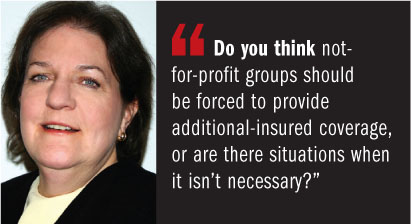One of the most common policy-endorsement requests is to add anadditional insured to a commercial general liability (CGL) policy.Parties who add others as additional insureds are sharing theirliability insurance with that other entity and may have to pay anadditional premium in order to do so. These endorsements generallypromise to defend the additional insured in the event of a claim orsuit.
| Typically, the insured thatcontrols the work or the property provides the primary insurance,adding the owner or landlord as an additional insured. For example,tenants add building owners as additional insureds; manufacturersadd vendors; and subcontractors add contractors or owners.
Typically, the insured thatcontrols the work or the property provides the primary insurance,adding the owner or landlord as an additional insured. For example,tenants add building owners as additional insureds; manufacturersadd vendors; and subcontractors add contractors or owners.
One relationship that may not be as obvious is that of afacility owner that insists on being added as an additional insuredon a temporary occupant's CGL policy. This doesn't seem unusualwhen a seasonal or holiday retail outlet sets up a kiosk ortemporary sales site in a mall.
|But what about civic and social groups that use school or retailareas for fund-raisers or meetings? In my community, a newly formedreligious group holds services in the high school building. TheScouts, sports booster groups and various health organizations meetin a variety of facilities, from malls to churches.
|Questions frequently arise about whether these not-for-profitorganizations—some of which are part of a national association(like the Scouts), and some of which are more loosely organized(like sports boosters)—should have to add the owners of facilitiesas additional insureds on a liability policy. I've been on bothsides of that fence.
|As an insurance professional I have recommended that buildingowners always require evidence of CGL insurance andadditional-insured status from all facility users, temporary andotherwise and regardless of amount of rent. As a member of civicorganizations, I have grappled with how the groups can afford theliability-insurance premium and possible additional premium foradding an additional insured.
|I've been trained to think of the worst-case scenario, when aserious injury or damage is caused by something the temporaryoccupant does. What if the local civic association inadvertentlyblocks a fire exit with its fund-raising display, and people areinjured because they cannot exit the facility?
|I believe two things: Serious injuries or damage may be rare,but they do occur; and claims are likely to be filed against everyconceivable party when such losses happen. This is the businesswe're in, and all of us have seen both. Although I empathize withcivic groups that think they cannot afford to pay for liabilityinsurance and additional-insured endorsements, we must be realistsand understand that having the appropriate coverage andadditional-insured provision is necessary.
|I'm not sure that the owners of facilities can afford not torequire additional-insured status from every organization that usestheir facilities. Do you think not-for-profit groups should beforced to provide additional-insured coverage, or are theresituations when it isn't necessary?
Want to continue reading?
Become a Free PropertyCasualty360 Digital Reader
Your access to unlimited PropertyCasualty360 content isn’t changing.
Once you are an ALM digital member, you’ll receive:
- All PropertyCasualty360.com news coverage, best practices, and in-depth analysis.
- Educational webcasts, resources from industry leaders, and informative newsletters.
- Other award-winning websites including BenefitsPRO.com and ThinkAdvisor.com.
Already have an account? Sign In
© 2024 ALM Global, LLC, All Rights Reserved. Request academic re-use from www.copyright.com. All other uses, submit a request to [email protected]. For more information visit Asset & Logo Licensing.








